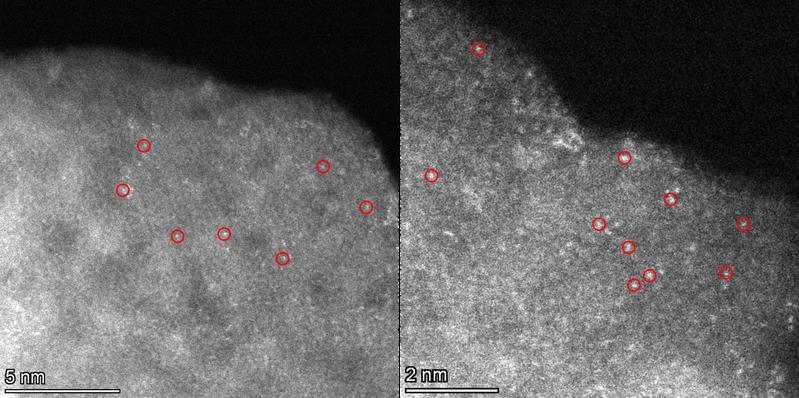Isolated Atoms in Great Shape - LIKAT Chemists Demonstrate Heterogeneous Catalysis for Synthesis of Complex Molecule
A catalyst developed at LIKAT in Rostock opens up new avenues in the synthesis of fine chemicals for pharmaceuticals, agrochemicals and household chemicals, for example. Its effect is based on isolated copper atoms applied to a solid carrier material around which the reaction solution flows. This heterogeneous catalysis, so called because the aggregate states of the catalyst (solid) and the starting materials (liquid) differ, is highly unusual in the production of pharmaceuticals, for example. The researchers report on the new approach in the journal CHEM.
Hot Topic: Heterogeneous Instead of Homogeneous
In the production of fine chemicals, chemists usually use the classic workhorse, homogeneous catalysis: starting materials, catalyst and end product are in a liquid mix (homogeneous, i.e. in the same aggregate state) in one vessel. One advantage of this catalysis is the mild reaction temperatures, which are gentle on the sensitive structures of these complex molecules.
However, homogeneous catalysis has decisive disadvantages. This is why one of the "hot topics" in chemistry is to replace these processes with heterogeneous procedures. Two Humboldt Fellows at the Leibniz Institute for Catalysis in Rostock have succeeded in doing this for a single step within a multi-stage reaction cascade that fine chemicals usually undergo during their production.
Dr. Qiang Wang and Dr. Haifeng Qi developed a heterogeneous copper catalyst and were able to use it to re-establish important bonds between carbon and other chemical elements in numerous complex molecules at moderate temperatures of 60 degrees Celsius.
Single-atom Structure on MOFs
When developing their catalyst, they applied the copper atoms to the carrier material in isolated form, i.e. individually. This so-called single-atom structure enabled Wang and Qi to enormously increase the precision of their catalyst, which chemists refer to as selectivity. Their copper catalyst has also outperformed the homogeneous process in terms of yield. "Individually, copper atoms offer the reaction environment a much larger surface area than when they are connected in clusters or nanoparticles," say Dr. Kathrin Junge and Prof. Jagadeesh Rajenahally, explaining the principle. Junge and Rajenahally are co-authors of the CHEM PAPER and scientifically supervised Haifeng Qi and Qiang Wang. The two Humboldt Fellows are now working in other research groups in China and the UK. Kathrin Junge explains the significance of her research: "Active ingredients, vitamins and fragrances are often modeled on nature and are created through total synthesis, which in turn can involve a dozen or more reaction steps."
After each step, the substances must be separated, purified and prepared for the next reaction stage. However, the catalysts, usually organometallic complexes, are difficult to recover from the homogeneous reaction solutions. And metal impurities represent a real hurdle for the approval of drugs, as the authors write in the original paper.
The two Humboldt fellows circumvented this problem by stably bonding their metal to a solid carrier material. They used organometallic framework structures as carriers, which have been making a name for themselves in chemistry for several years under the name MOFs. "These MOFs contain structures similar to those of ligands in homogeneous catalysts," explains Dr. Junge. Their function is simulated to a certain extent with the help of the corresponding structure in the heterogeneous copper catalyst.
Substances selected for specific applications
Qiang Wang and Haifeng Qi demonstrated the functionality of their heterogeneous catalyst using a variety of complex molecules that are used in organic synthesis chemistry. For example, for the production of pharmaceuticals, vitamins in animal feed production and fragrances in household chemistry. Dr. Junge: "The two colleagues have thus shown that their research work really does have potential applications in mind." Or, as the original paper puts it: "The use of more stable heterogeneous materials is a model for future catalysis in the field of organic syntheses."
Wissenschaftlicher Ansprechpartner:
Dr. Kathrin Junge
Group Leader "Sustainable Redox Reactions"
Kathrin.junge@catalysis.de
Prof. Jagadeesh Rajenahally
Group Leader "Catalysis for Sustainable Syntheses"
Jagedeesh.rajenahally@catalysis.de
Originalpublikation:
Q. Wang, H. Qi, Y. Ren, Z. Cao, K. Junge, Rajenahally V. Jagadeesh, M. Beller, Chem 2024. A general atomically dispersed copper catalyst for C-O, C-N, and C-C bond formation by carbene insertion reactions. DOI: 10.1016/j.chempr.2024.02.021
Weitere Informationen:
https://www.catalysis.de/en/research/applied-homogeneous-catalysis/redoxreactions
https://www.catalysis.de/en/research/applied-homogeneous-catalysis/synergy-between-homogeneous-and-heterogeneous-catalysis
Die semantisch ähnlichsten Pressemitteilungen im idw



